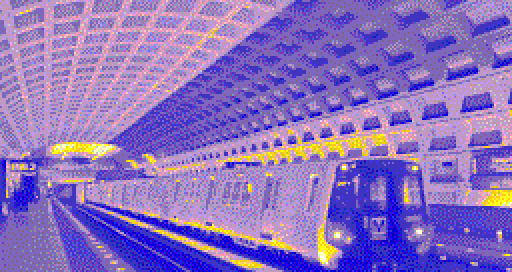One of the authors I recommend on Substack is The Deleted Scenes by Addison Del Mastro. He writes about “urbanism, land use, suburbs, small towns, and the built environment in general.” He occasionally forays into technology, from the layman’s perspective.
Today’s post, nominally about fare evasion on transit systems and civic pride, had a beautiful description of the D.C. Metro system (italics in original, bold added):
But I remember, when I first moved to Maryland for grad school and when I first started working in D.C., I quickly realized how important transit is for cities. I didn’t grow up in a city, and at that time I had none of the knowledge of urbanism that I have now. But the geometry of cars just does not work in cities—it did not take me long to learn not to drive into D.C. if I could at all help it. You need transit to facilitate the movement of a lot of people in relatively compact spaces. Transit works in cities the way Interstates work to connect cities.
But beyond that sort of technical layman’s understanding, I quickly felt a sense of local pride in and affection for the Metro. Its branding, its iconic pylons outside the stations, even its quirks (why do we come to a full stop and then inch up to the platform just as everyone is standing up?) I felt that these trains crisscrossing the city day and night connected us—they were both a sign and a reality of the city’s motion and its community. A crowded Metro car to me feels like the city’s living room. It’s one of the few places where you really see a full cross-section of the whole place you live in.
Good technologies do this - they are a friendly part of life within the person, the home, the city. The reason trains can do this is because their motion is also their rider’s motion - the motion of the city (who is going where when) forms the basis of the train’s motion. It ebbs and flows over the day and week and year, following the natural and artificial rhythms of life within the city. Admittedly, I’m already something of a fan of commuter trains, but with Del Mastro’s description, I almost imagine trains with faces like something out of a Studio Ghibli film.
But that phrase— a sign and a reality—hmm! Familiar. One quality of a sacrament I am familiar with is that it “signifies what it effects.” Baptism is a washing with water, Baptism washes away sins. The Eucharist sustains us physically (at least a little), the Eucharist also sustains us spiritually.
For a longer description, consider this passage from the Catena Aurea (Golden Chain), a collection of writings from the early Church put together by Thomas Aquinas, there is a comment from Augustine about Matthew 3:13-15 (the Baptism of Christ):
The Saviour willed to be baptized not that He might Himself be cleansed, but to cleanse the water for us. From the time that Himself was dipped in the water, from that time has He washed away all our sins in water. And let none wonder that water, itself corporeal substance, is said to be effectual to the purification of the soul; it is so effectual, reaching to and searching out the hidden recesses of the conscience. Subtle and penetrating in its own nature, made yet more so by Christ’s blessing, it touches the hidden springs of life, the secret places of the soul, by virtue of its all-pervading dew. The course of blessing is even yet more penetrating than the flow of waters. Thus the blessing which like a spiritual river flows on from the Saviour’s baptism, hath filled the basins of all pools, and the courses of all fountains.
Are good technologies sacramental? I think so. As I write about in “Screens are Anti-Sacramental?”, it seems like electronic media / screens / computers / what-have-you doesn’t signify in this way (yet1) as trains seem to do now. That is in part because it is new (certainly on the timescale of societies) and in part because it’s more powerful (as it naturally would be considering we’ve reached it later in the arc of history). Good design and thoughtful usage of computing, I believe, can help get us there.
Don’t leave this post as one-way propaganda, join in the conversation here on Substack or the Discord server. Here are some questions that I’m curious about:
What other technologies in your life that are a beautiful sign and reality of the people or the good that they’re for?
Are there electronic or media technologies in your life that do have this characteristic, too?
What might need to change in some electronic technology to be more sacramental?
Finally, here’s Addison Del Mastro’s substack:
I have hope it is possible, but even establishing that is part of the question. As Marshall McLuhan describes, the lightbulb is a medium without a message, and light / electronic media are particularly amorphous. I don’t think any sacraments involve light… perhaps the closest is the Easter candle? But even then, a candle isn’t a medium in the same way the lightbulb is…





